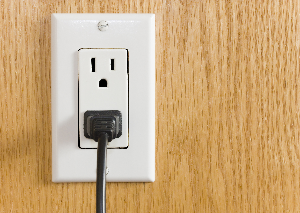Is your home on the aged side? Homes built many years ago were not guided by the same electrical standards used today. Did you buy a DIY wonder home with weird wiring issues and cheap switches? Modern safety rules might have been bypassed when electrical receptacles and switches were installed.
If you doubt the safety of your wall switches and receptacles (also called outlets), hire a licensed electrician to inspect and replace questionable ones. Here are three important reasons to have all of your switches and outlets replaced.
- Receptacles Are Not Tamper-Resistant
If your household includes small children or adults with cognitive impairment, you need to install tamper-proof outlets on all wall receptacles. Tamper-resistant outlets decrease the risk of accidental shock and electrocution to vulnerable loved ones.
In 2015, approximately 5,500 people visited a hospital emergency room due to electrical-outlet injuries. Nearly 2,400 children a year are burned and shocked after sticking nails, flatware, and other conductive materials into wall outlets.
Tamper-resistant receptacles are now required by the National Electrical Code (NEC) in some new buildings and when making major renovations of structures that are inhabited by children. The tamper-resistant outlets cost less than a dollar per receptacle more to install than standard outlets.
Tamper-resistant outlets require the presence of both prongs in a plug to make the connection between the metal prongs and the electrical current. A single prong opening won’t open when a nail or other object is inserted into that side, so no current can flow from the outlet to a child or an adult with dementia.
Tamper-resistant outlets work more effectively than sliding-type covers that children learn how to defeat. Plug-in outlet protectors can become choking hazards for crawling and toddling kids and are often easy for small fingers to pry loose. In one study, every toddler was able to remove a specific brand of outlet cover within 10 seconds.
When combined with GFCI protection, tamper-resistant outlets reduce opportunities for electrical shocks and burns. Your licensed electrician installs and tests the tamper-resistant plugs to ensure they work properly.
- Receptacles Need GFCI Protection
Without ground fault circuit interruption (GFCI), you could be electrocuted by a bad appliance or outlet. Ground faults are pathways between electrical current and grounded material. If an appliance or outlet is damaged or faulty, you become the pathway, or the ground fault.
A GFCI is designed to respond immediately when it senses that the amount of electrical current returning to the circuit is not appropriate. If the GFCI’s monitoring indicates a variation between the power going out and the power coming back from the appliance, the GFCI shuts the power off before damage to a person occurs.
A slight variation from the amount of electrical current supplied to the circuit is all it takes to interrupt power flowing to an appliance. A reset button allows you to use the outlet again after unplugging the unsafe appliance.
The NEC has required GFCI protection in specific applications since the late 1960s. However, these rules generally applied only to new buildings and major renovation projects.
If your older home is without GFCI outlets, you need a qualified, licensed electrician to install the receptacles in:
- Kitchens
- Bathrooms
- Crawl spaces
- Unfinished basements
Anywhere there’s a potential for water to become a ground fault (and a source of electrocution for any persons touching that water) or where there are electrical tools, you need GFCI protection. GFCI outlets should be placed near wet bars, over laundry sinks, and in workshops and sheds where power equipment is used.
There are several types of GFCI products. Some are installed at the breaker box to protect an entire branch line of your electrical system. Other types of GFCI devices act at the outlet but may protect devices further down the same line.
3. Receptacles and Switches Leak Air
Electrical receptacles and switches are a source of leaks into rooms. Depending on how your home is constructed, unconditioned air and air from outside may be able to enter receptacle boxes and spill into your home.
Cold or hot air enters the wall switches and outlets via holes in the framing. Air seeps into uninsulated junction boxes and follows the path of least resistance into your home.
Air can enter the junction-box space from:
- The attic
- The basement
- Crawlspaces
- The garage
On a frigid Chicago morning, receptacle air leaks can make nearby rooms feel uncomfortably cold. The air leaks also increase energy costs to heat and cool indoor spaces.
Gaskets can be fitted over the backs of switches and outlets, but the gaskets don’t block all of the air. Instead, hire your electrician to install airtight junction boxes or junction-box covers when building a new home. Have switches and outlets replaced with airtight junction boxes when renovating an older home. Some covers work with standard junction boxes to create a good air seal.
Contact A To Z Electric Co. to schedule repair or replacement of your electrical switches and outlets in the Greater Chicagoland region.

